Tom's Guide Verdict
The Pixel 3a has far and away the best camera, software and display you could hope for in a $400 phone.
Pros
- +
Flagship-caliber camera
- +
Google software and support
- +
Solid build
- +
OLED display
- +
Low price
- +
Excellent battery life
- +
Supports all carriers
Cons
- -
No water resistance
- -
Performance is good, not great
- -
Display could be brighter
- -
No wireless charging
Why you can trust Tom's Guide
The Google Pixel 3a is less than half the price of most flagship phones, and yet it doesn’t look or feel cheap. That’s because Google delivers the features most users really care about with this device, including a vivid 5.6-inch OLED display, a fantastic camera and all of the company’s clever software, for just $399.
However, it's been replaced on our list of the best phones by its successor, the new Google Pixel 4a. While last year's model is still one of the best cheap phones out there, Google has since discontinued it, plus the Pixel 4a is a superior phone in practically every way and costs $50 less.
Nevertheless, the Pixel 3a is still worth picking up if you can find one at a compelling discount. That's especially true for those interested in the Pixel 3a XL for its larger display, as Google skipped making a 4a XL variant for the latest generation.
Editors' Note: The Pixel 3a had made way for the Pixel 4a, of course, but you can see what's new in our Google Pixel 4a vs. Pixel 3a face-off.
Google Pixel 3a: Price and availability
Until recently, the Pixel 3a was available for $399 from most carriers and retailers, but has since been discontinued and replaced by the Pixel 4a. That said, you can still find it at T-Mobile.
There’s only one configuration of the Pixel 3a and 3a XL, with 64GB of storage and 4GB of RAM. Neither phone features a microSD card slot, so there’s no way to expand that limited amount of space if you fill it all up with photos and apps. The system itself takes up about 5GB, and once you factor in pre-installed apps, you’re looking at around 50GB of usable storage out of the box.
Google Pixel 3a: Design
The Pixel 3a doesn’t feel cheap, though its polycarbonate back does give away its price. This phone is also very light and compact, measuring 6 x 2.8 x 0.3 inches and weighing just 5.2 ounces. As someone who uses the hulking iPhone XS Max with its 6.5-inch screen, the Pixel 3a seems almost cute.
Get instant access to breaking news, the hottest reviews, great deals and helpful tips.

The Pixel 3a is available in Just Black, Clearly White and Purple-ish, and I gravitated towards the latter because it just seems more fun. The trademark two-tone Pixel design, combining matte and glossy surfaces on the back, has been kept intact for the Pixel 3a; although this device is technically made of plastic, it honestly feels almost as sturdy and strong as glass. This is hardly the most breathtaking handset out there aesthetically speaking, but there’s no denying it’s well made.
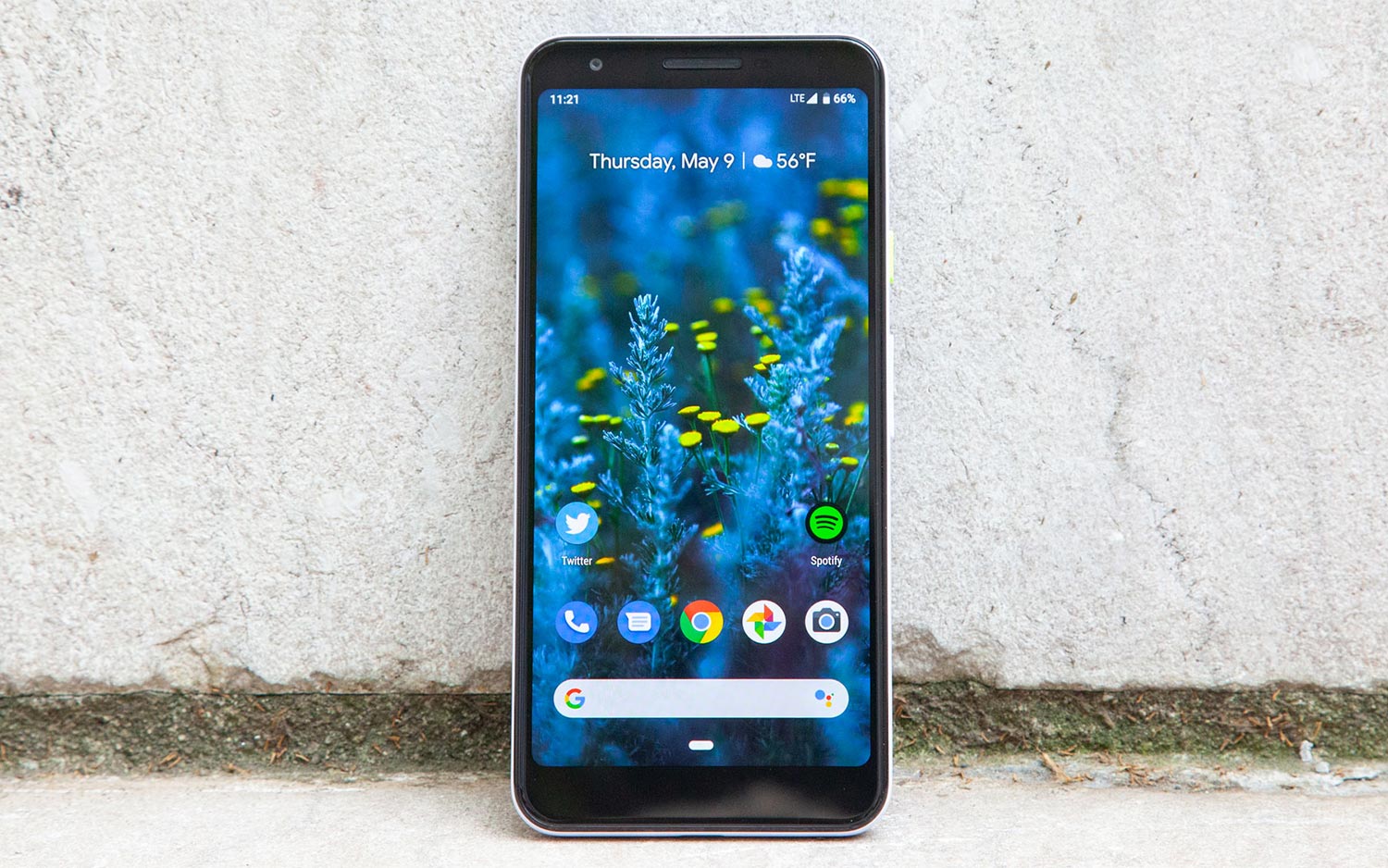
As for the front, Google has replaced Corning’s Gorilla Glass, used in the pricier models, with AGC’s Dragontrail strengthened glass — an alternative usually found in cheaper handsets. And just as the back of the Pixel 3a is a spitting image of those other Pixel phones, so too is the front. The only noticeable differences are the lack of a second front-facing camera for wide-angle selfies, and a slightly thicker bottom bezel without a second speaker stashed below the display.
- The best small phones available now
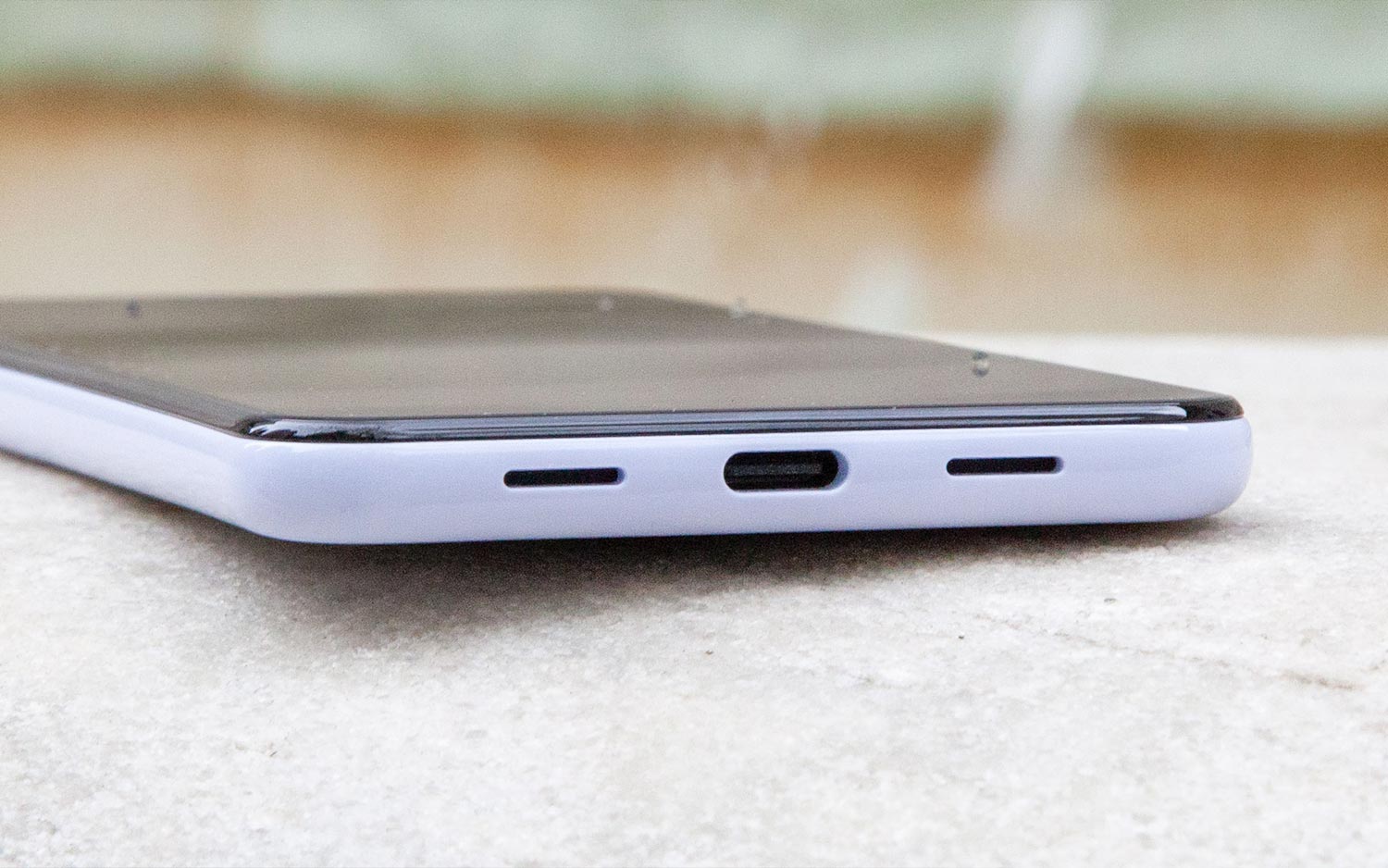
While the Pixel 3a does still feature stereo sound, it fires audio through the earpiece and slits beside the USB Type-C port along the lower edge. Those speakers can get pretty loud, but the quality appears a bit more compressed than what you get from the Pixel 3 and 3 XL.

Thankfully, all Pixel 3a phones come with a headphone jack, but none of them offer water resistance. That latter point is a bit of a bummer, though not at all unusual for phones in this price range. And although it’s a small point, I have to commend Google for incorporating the Pixel 3’s fantastic haptic motor in this phone. Tapping away at on-screen keys on the 3a feels so much nicer than it does on any similarly-priced handset, thanks to perfectly weighted blips that fire immediately.
Google Pixel 3a: Display
I’m glad that Google went the OLED route for the Pixel 3a’s screen, which means you’ll enjoy vibrant colors, wide viewing angles and perfect blacks for a good price. The resolution is pretty good, too, at 2220x1080 pixels.
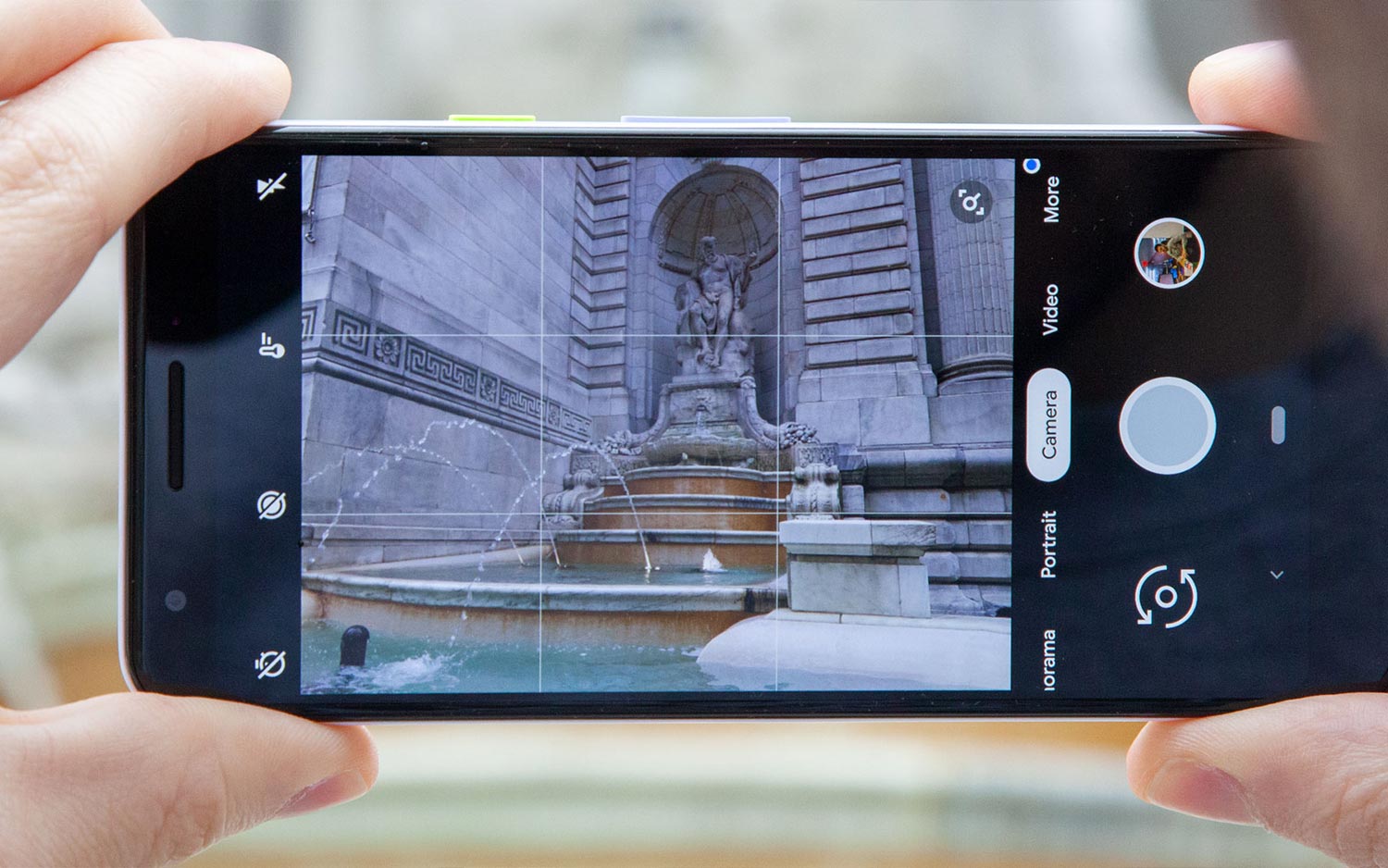
In fact, if having an OLED panel is important to you, the Pixel 3a currently offers the cheapest path to getting one. Just don’t expect the finest display for the price.
Next to the Pixel 3, the 3a’s screen falls short in terms of color intensity and exhibits a warmer white balance, even when on Dynamic mode, the most saturated of the three profiles the handset offers. It’s by no means a poor experience — rest assured, we’re not talking Pixel 2 XL-levels of disappointment here — but it does leave a bit to be desired if you’ve ever been mesmerized by the really fantastic OLED panels in the latest Galaxy S handsets and iPhones.
The Pixel 3a’s display could be brighter, too. It was tough to make out the Avengers: Endgame trailer in sunlight even when the phone was set to maximum brightness. With a peak of 401 nits, this display comes in well below the 488-nit average, though its sRGB color gamut coverage and Delta-E accuracy scores of 182.3% and 0.18, respectively, are very good and in line with modern flagships.
If having an OLED panel is important to you, the Pixel 3a currently offers the cheapest path to getting one. Just don’t expect the finest display for the price.
Ultimately, what few complaints you’d have about the Pixel 3a’s screen feel like nitpicks given how little you’re paying. In an $800 phone, you might feel short-changed, but in a device that costs half that, getting a good but not great OLED feels like a bargain — minor imperfections and all.
Personally, I'd probably opt for the 6-inch Pixel 3a XL, as I would want more real estate for typing and watching videos, but there is a $80/£70 price difference between the two variants.
Google Pixel 3a: Camera
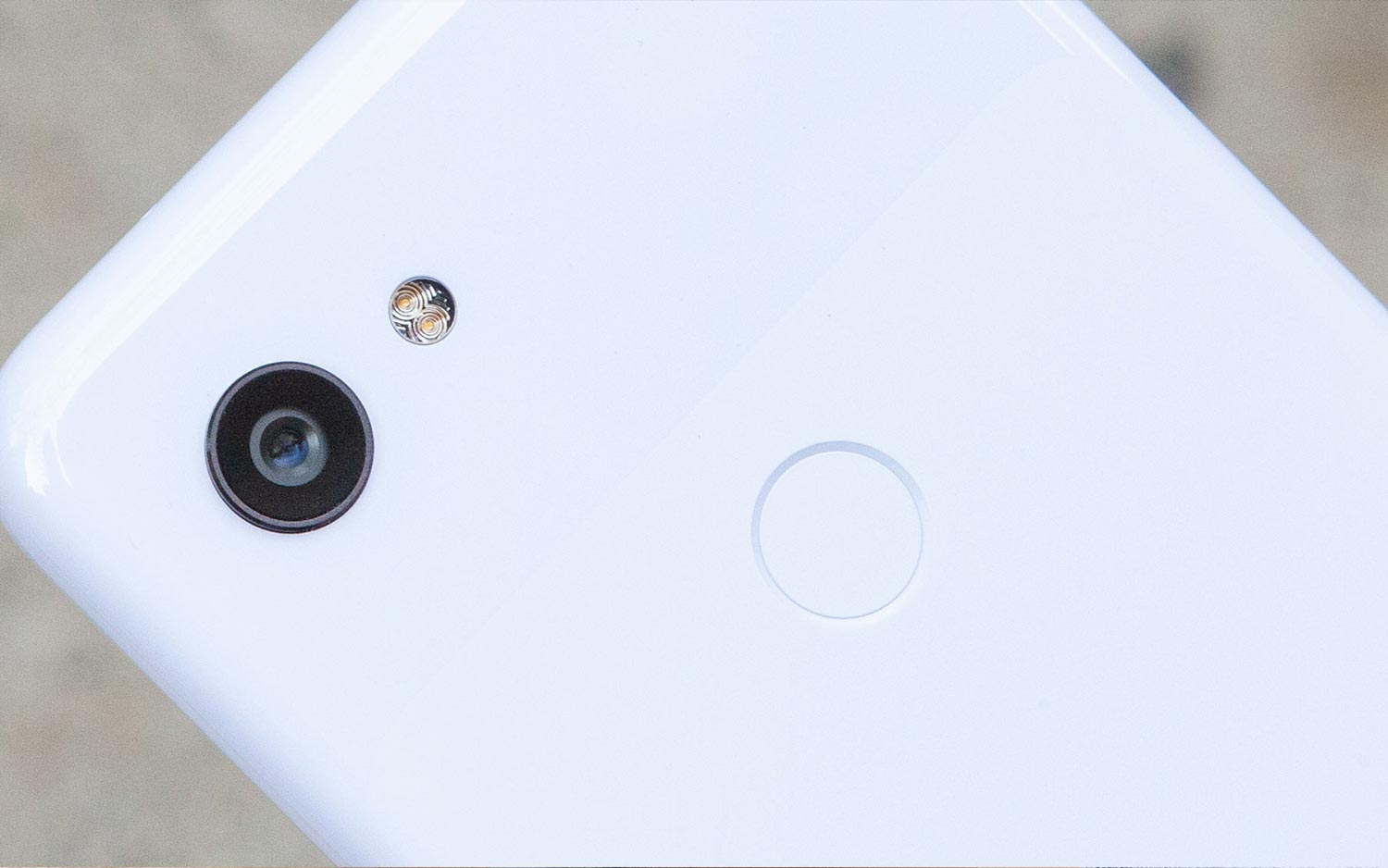
Google deserves credit for bringing all of the key camera features of the Pixel 3 to its cheaper cousin. The Pixel 3a offers a single rear camera at 12.2 megapixels with a f/1.8 aperture, and it can do all sorts of tricks. That includes Night Sight, which allows you to capture great photos even in complete darkness, as well as bokeh Portrait Mode and Super Res Zoom, for digital zoom that’s comparable with optical.
If you had any doubt the Pixel 3a would be able to punch above its weight class, this portrait it captured of my colleague Caitlin should put those fears to rest. The optics and much of the hardware behind the Pixel 3a’s rear camera is identical to what you get in the Pixel 3; the only difference is that the 3a lacks the Pixel Visual Core image processing chip.
You’re getting Night Sight, in all its reality-defying glory, in a $400 phone.
That doesn’t appear to be a massive setback, however, as the 3a still has the muscle to deliver a shot that exceeds the Galaxy S10 Plus’ best effort in many respects. Caitlin’s skin tone is better represented through the Pixel’s lens, and while I could do without some of the unusual artifacting along the left side of her face, the S10 Plus’ strange metering and more zoomed-out perspective are more egregious faults to my eye.
You could certainly make the argument that the S10 Plus won out in this comparison between shots of a pink rose, but the Pixel 3a’s result is so much closer than a phone that costs less than half the price has any right to be. Samsung’s rendition is a hair sharper across the board, and the company’s Scene Optimizer tech was able to punch up those shades of magenta in the petals, to produce a more vivid shot than Google’s handset could manage. But then the Pixel 3a’s attempt is still very, very good, with a bit more detail rendered in some areas where the S10 Plus trades definition for saturated colors.
It’s only when you see what the Pixel 3a can do compared to a phone roughly the same price that you really begin to appreciate how special its camera is. The shot from the edge of Bryant Park as captured by the $349/£300 Nokia 7.1 isn’t bad at all, but it falls short in ways even the best midrange phones for photography do. The sky is blown out, the foliage is sort of blurry, the patina of the grass is glazed over and ultimately the way the Nokia lit the scene simply isn’t true to the day’s actual conditions. And yet the Pixel 3a can effortlessly render this gloomy scene in a beautiful way.
And then, of course, there’s Night Sight — a feature that has made its way to the Pixel 3a gloriously intact, and capable of the same feats of software magic that it grants in the Pixel 3. In fact, compared to the Pixel 3, it’s hard to notice a difference in the quality of the photos between them; perhaps the flagship’s example is a hair warmer, maybe the shadow of the railings against the green-painted wood is a bit more pronounced through the lens of the pricier model. Though again, these are negligible differences you likely wouldn’t notice unless you were deliberately looking for them. The fact is, you’re getting Night Sight, in all its reality-defying glory, in a $400 phone.
Finally, the Pixel 3a’s front 8-MP camera is serviceable, but you don’t get the extra wide-angle lens that the regular Pixel 3 offers, so group selfies are a little more challenging. The Pixel 3a’s front-facing shooter can’t autofocus, either, which means you’ll have to be careful about how you position your mug in those instances. All that considered, though, the Pixel 3a can still take a pretty satisfying selfie that’s once again right up alongside flagship metal.
Google Pixel 3a: Performance
Armed with a Snapdragon 670 processor and 4GB of RAM, the Pixel 3a feels snappy enough for everyday tasks. In fact, most of the time, it was hard to discern a difference in responsiveness compared to the Snapdragon 845-powered Pixel 3 with respect to opening and closing software and scrolling in apps.
MORE: Best Apps for Benchmarking Smartphones or Tablets
The sprightly performance isn’t quite so surprising once you look at the benchmarks. The Pixel 3a punched in a score of 5,146 in the system-wide Geekbench 4 test. For a bit of perspective, that’s almost smack-dab in the middle between the original Pixel’s 4,176 result and the Pixel 2, at 6,282. The Nokia 7.1, a modern adversary for the Pixel 3a featuring a slightly less-powerful Snapdragon 636 CPU, couldn’t quite match Google’s new handset, as it fell just short at 4,953.

All of that bodes well for the Pixel 3a in an everyday context. Where you're likely start to notice lag is when playing demanding games, or using the camera a lot. (It's still one of our best handheld gaming consoles, thanks to its good selection and Google Stadia compatibility.) Although the Pixel 3a can pull off many of the same computational photography tricks that Google’s more expensive models can, all that image crunching is happening on less-capable silicon, and without Google’s Pixel Visual Core to speed things along. That means sometimes you’ll have to wait a hair longer for HDR+ photos or bokeh-effect portraits to finish processing after the fact. It’s not deal-breaking lag by any stretch, but it can happen.
As for gaming, the Pixel 3a fares better than most phones at its price range, though it handles some titles better than others. PUBG Mobile wasn’t much of a sweat for the baby Pixel, though Asphalt 9: Legends was a choppier, blurrier experience. This is hardly surprising given the handset’s 1,602 score in 3DMark’s Sling Shot OpenGL ES 3.1 test — a long way from the Pixel 3’s 4,400 points, let alone the Galaxy S10’s best effort of 5,606.
Google Pixel 3a: Battery life
The Pixel 3a comes with a fairly small battery at 3,000 mAh, though that’s still a bit more than you get from the 2,915-mAh capacity of the Pixel 3. Coupled with the Pixel 3a’s processor, which features more cores dedicated for low power consumption rather than high performance, this phone can actually last quite a bit longer on a charge than its premium counterpart.
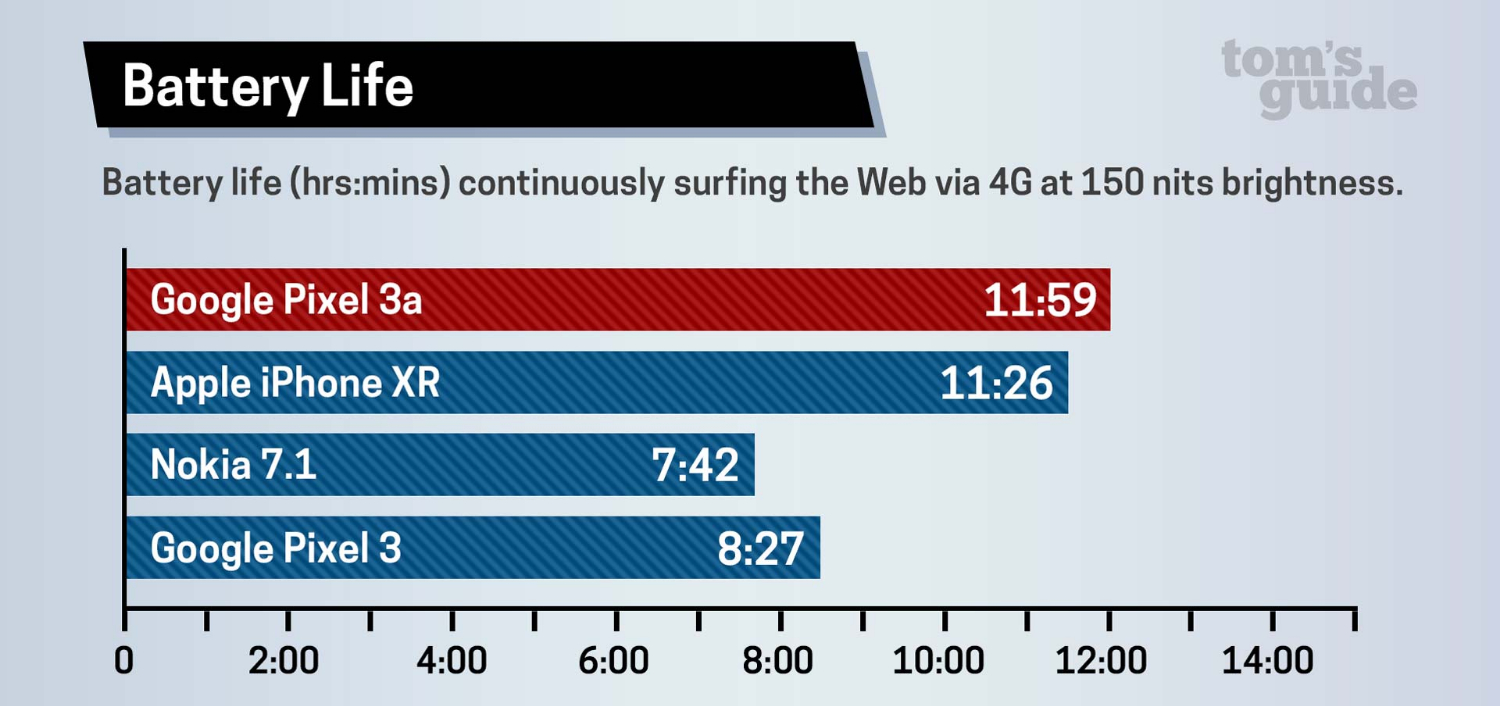
Google’s latest handset turned in 11 hours and 59 minutes in our battery test, where the device cycled through web pages over an LTE connection at 150 nits brightness until it ran out of juice. That’s significantly longer than the $349/£300 Nokia 7.1’s 7:42 result, and even exceeds Apple’s $749/£749 iPhone XR, which managed 11:26.
MORE: Best phone battery life: Longest lasting smartphone batteries
Even better, you could get as many as 7 hours of battery life with just 15 minutes of fast charging; the Pixel 3a comes with an 18-watt fast charger in the box. Unfortunately however, Google did have to skimp on the Pixel 3’s wireless charging to achieve the lower price.
Google’s latest handset turned in 11 hours and 59 minutes in our battery test, which beats the iPhone XR.
Google Pixel 3a: Software and special features
While I suspect many budget buyers will flock to the Pixel 3a for its camera, Google’s work on the software side of things shouldn’t be overlooked. Because even in this cheaper handset, Google has brought its best and most innovative features to the forefront.

That includes Call Screen, which leverages the power of artificial intelligence to deal with unidentified callers so you don’t have to, as well as Active Edge, which lets you quickly launch Google Assistant only by squeezing the sides of the device.
The Pixel 3a launches with Android 9 Pie, though it already is eligible for the Android Q Beta, and will receive the full release as soon as it launches for the public in late summer or early fall.
Really, the best thing you can say about the Pixel 3a’s software experience is that there isn’t much to say about it; this is the same great flavor of Android that people buy $800 Pixel flagships for, but now it’s running on hardware that costs half that. And the fact it also comes with three years of guaranteed software updates and monthly security patches ensures a level of support that no other smartphone at this price range enjoys.
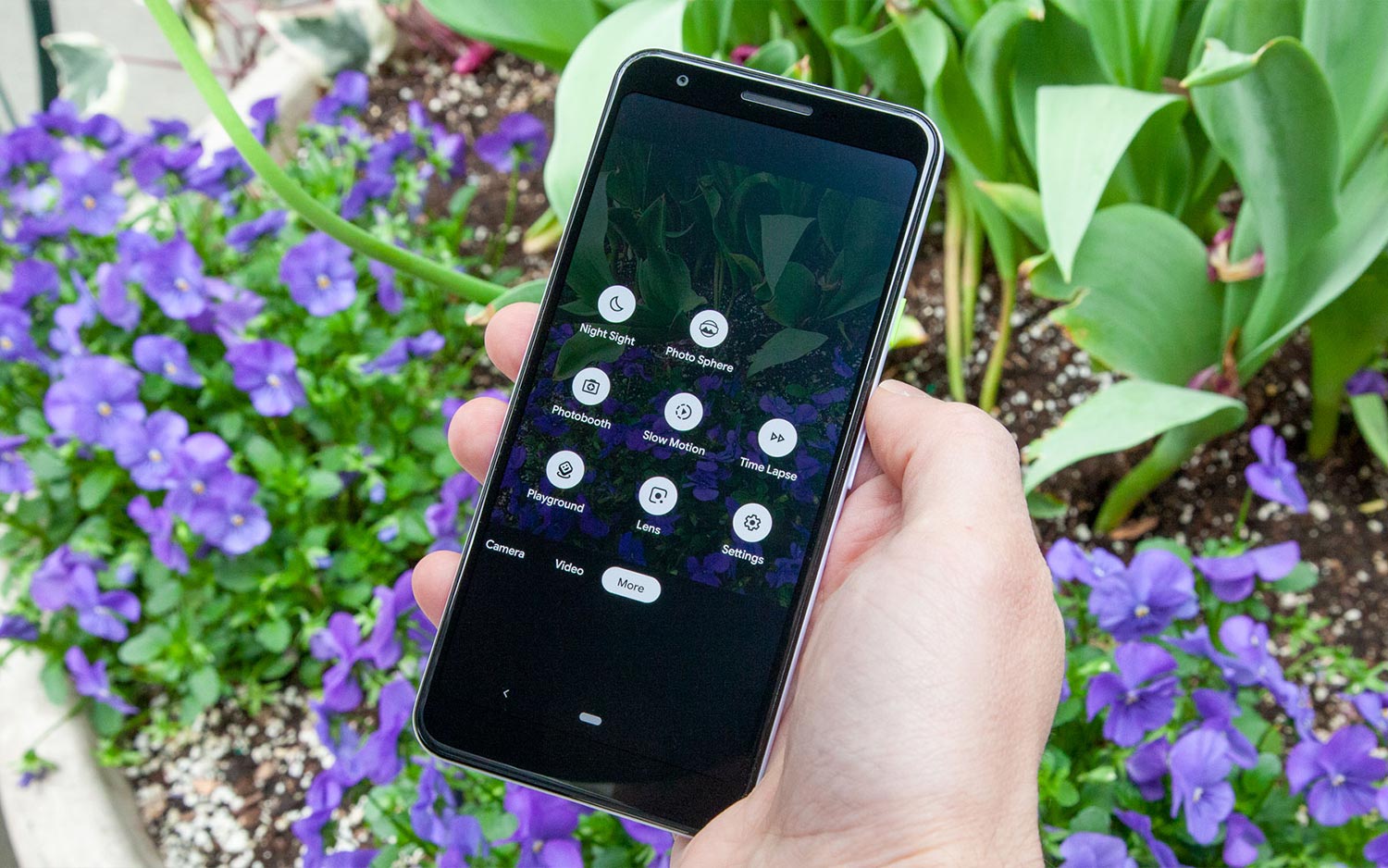
The only gripe I have is that the Pixel 3a misses out on the two years of unlimited original-quality uploads to Google Photos that every previous Pixel has enjoyed. Rather, you get the same limited 15GB allotment for full-resolution images and unlimited “high quality” storage that every other Android phone is already eligible for.
Google Pixel 3a: Verdict
The Pixel 3a is a steal for those who simply don't want to spend a lot on their next phone and still get a great camera. The specs are decent for the $399/£399 price, and you don't have to deal with the usual carrier bloatware that you'll typically find on other midrange phones.
In fact, aside from a slight hit to performance, the Pixel 3a avoids nearly all of the frustrations that ordinarily befall other cheap handsets — and that includes good ones like the $349/£300 Nokia 7.1 and $299/£240 Moto G7. The build quality is excellent, the display is a cut above any run-of-the-mill LCD screen, the battery lasts very long on a charge, and the software consists of Google’s latest and greatest services, with the promise of quick updates for three years. Most budget devices are lucky to see one update in their entire lifetime.
Of course, the Pixel 3a's biggest rival is Google's new Pixel 4a, which offers a better processor, camera, design and display for $50 less. The 4a has rendered the 3a obsolete, sadly, especially because you can't buy a new Pixel 3a from most official retail channels anymore. That said, if you can track one down for well under list price or perhaps secondhand, it remains a great choice for just about anyone in need of a great cheap phone.
Adam Ismail is a staff writer at Jalopnik and previously worked on Tom's Guide covering smartphones, car tech and gaming. His love for all things mobile began with the original Motorola Droid; since then he’s owned a variety of Android and iOS-powered handsets, refusing to stay loyal to one platform. His work has also appeared on Digital Trends and GTPlanet. When he’s not fiddling with the latest devices, he’s at an indie pop show, recording a podcast or playing Sega Dreamcast.

